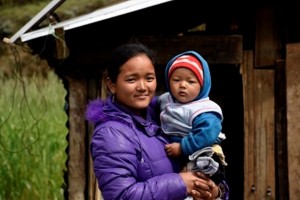In Nepal, growing up at the epicentre
2016-04-21
© UNICEF/2016/Karki - Amita and Arpita overlook the mountainous landscape outside of a temporary shelter. Since the quake, Amita and her daughter have been living with 40 other displaced families away from their home village.
By Avinashi Paudel
In Nepal’s quake-affected village, a young mother struggles to raise her daughter born on the day of earthquake.
GORKHA, Nepal/HONG KONG, 21 April 2016 – “I love my daughter the most in the whole world,” said Amita Gurung, holding her baby Arpita tightly in her arms. "But when I think of the day she was born, I feel like crying."
It was a dull Saturday afternoon. Nine-month pregnant Amita was lying lazily on her bed watching television. Suddenly she heard a rattling sound and her sister screaming “Earthquake! Earthquake!”
Amita’s memory of dragging herself out of the collapsing house when the whole world seemed to be rocking still feels like a bad dream.
The day was April 25, 2015, and a devastating earthquake had just hit central Nepal. Amita's village was at the epicentre.
Amid destruction, a new lifeA couple of hours after the earthquake, Amita felt an ache in her stomach. She told her father-in-law about her discomfort, and he immediately identified it as labour pain. Amita was taken into a cowshed to prepare for giving birth.
After three intense hours of labour, baby Arpita’s first cries rang out, eathing new life into the village. Families and villagers were in awe of the power of nature to create doom and bloom at the same time.
“So many people died in the village that day. But we two were alive,” said Amita. “It felt weird but I was happy that we two survived.”
After Arpita’s birth, the new mother’s happiness was overpowered by her growing fears about their survival. “Everything was destroyed and buried, I was worried about what to eat, what to wear, where to sleep,” recalled Amita. “I wondered about whether the constant shaking would harm my daughter.”
Amita had intended to go to the health centre to give birth, but nothing had gone as planned. She could not even meet the Female Community Health Volunteer (FCHV) when she felt the first pains of labour.
“I thought the health post might as well have been destroyed and I was worried how I and my daughter would get medicine if we needed any,” she said.
Amita is grateful for her family members who cared for her even when they were concerned about their own safety. Despite the chaos, they ought her hot water to drink and boiled instant noodles to eat. They immediately scraped together wood and clothes to build a makeshift bed for her and Arpita. Later, they fetched ghee, rice and eggs to make sure she had food that would fulfill her nutritional needs as a new mother.
Like many young people in her village, Amita’s husband has gone aoad to the United Arab Emirates for work. Amita managed to show him a photo of their daughter by uploading it through a friend's account. “He said our daughter looked beautiful!” she said with a grin.

© UNICEF/2016/KarkiAmita Gurung holds her daughter Arpita in the remote Chomar village of Nepal's Barpak Village Development Committee in Gorkha District. Arpita was born on April 25, the day a 7.8-magnitude earthquake hit Nepal.
One year later
Before the earthquake, Amita had a clean and beautiful house. There was a smokeless stove inside, with a toilet and water tap close by. Now, nearly a year after the earthquake, Amita is living with 40 other families in a corrugated iron (CGI) sheet shelter away from her village.
“It is very uncomfortable living in here, especially when it rains, and it is accompanied by hailstone and strong winds,” Amita said. “The toilet is far away and stinks. The tap is also far off and water is in short supply.”
Despite the poor living conditions, Amita made sure that Arpita received all of the required doses of vaccines. She frequently meets with the FCHV to discuss how to take better care of her daughter and what to feed her.
Arpita seems like an alert baby, on the ink of taking her first steps. But her mother is worried about her. "Arpita falls sick often with bad wheezing cough," she said. “It might be because of the excessive cold under the CGI sheets and also due to the smoke from cooking indoors.”
Although Amita is unsure when she will be able to give her daughter a better life in more stable conditions, she is determined to do so. Married at a tender age and unable to pursue her education because of her pregnancy, Amita wants more for her daughter. “I want my daughter’s future to be a lot different than mine," said Amita. "I want her to be as educated as she wants to be!”
UNICEF is working with the Government of Nepal and other development partners in the 14 districts hit hardest by the earthquake. Efforts include strengthening health, education, nutrition and WASH facilities and services for the 1.1 million children like Arpita who were affected.









